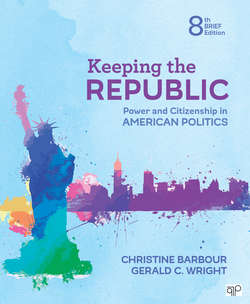Читать книгу Keeping the Republic - Christine Barbour - Страница 112
На сайте Литреса книга снята с продажи.
American Federalism Over Time: Constitutional ambiguity and the role of the Supreme Court
ОглавлениеAlthough the Constitution provides for both national powers and state powers (as well as some shared powers), the balance between the two has changed considerably since it was written. Because of the founders’ disagreement over how power should be distributed in the new country, the final wording about national and state powers was intentionally kept vague, which probably helped the Constitution get ratified. Because it wasn’t clear how much power the different levels held, it has been possible ever since for both ardent Federalists and states’ rights advocates to find support for their positions in the document.
That very vagueness has opened the door for the Supreme Court to interpret the Constitution’s meaning. Those interpretations have varied along with the people sitting on the Court and with historical circumstances. As the context of American life has been transformed through events such as the end of slavery and the Civil War, the process of industrialization and the growth of big business, the economic collapse of the Great Depression in the 1930s and the relative prosperity of the late 1990s, the terror attacks of September 11, 2001, and the recession that began in 2008, the demands made on the different levels of government have shifted, too. When we talk about federalism in the United States, we are talking about specific constitutional rules and provisions, but we are also talking about a fairly continuous evolution of how those rules are understood. Consequently, the norms underlying federalism provide less of a fixed standard against which we can measure actual behavior; the norm is that although the federal government is supreme, the relationship is characterized by flexibility.
Two trends are apparent when we examine American federalism throughout our history. One is that American government in general is growing in size, at both the state and national levels. We make many more demands of government than did, say, the citizens of George Washington’s time, or Abraham Lincoln’s, and the apparatus to satisfy those demands has grown accordingly. But within that overall growth, a second trend has been the gradual but uneven strengthening of the national government at the expense of the states.
The increase in the size of government shouldn’t surprise us. One indisputable truth about the United States is that, over the years, it has gotten bigger, more industrialized, more urban, and more technical. As the country has grown, so have our expectations of what the government will do for us. We want to be protected from the fluctuations of the market, from natural disasters, from unfair business practices, and from unsafe foods and drugs. We want government to protect our “rights,” but our concept of those rights has expanded beyond the first ten amendments to include things like economic security in old age, a minimum standard of living for all citizens, a safe interstate highway system, and crime-free neighborhoods. These new demands and expectations create larger government at all levels, but particularly at the national level, where the resources and will to accomplish such broad policy goals are more likely to exist.
The national government has grown so large, so quickly, that the proper balance of power between the national and state governments is a central and controversial political issue today, and one that has traditionally divided the liberals and conservatives we spoke of in Chapter 1. Liberals believe a strong central government can solve society’s problems, especially economically, and conservatives believe that “big government” causes more problems than it solves. People in the latter category, like the Anti-Federalists at the founding, would prefer to see power and the distribution of government services located at the state or local level, closer to the people being governed. From 2000 to 2006, and again after 2016, however, with Republicans holding the reins of power in both the legislative and the executive branches, the conservative distaste for big government waned somewhat, as they were the ones dictating the actions of that government. President George W. Bush’s No Child Left Behind Act, for instance, took away many of the prerogatives of local school districts to decide whether to engage in regular testing of students, and yet the law enjoyed the support of many conservatives. Also, as we have noted, many conservatives have begun to argue for an expanded national role in regulating morals, if not the economy, and the need to address national security issues after September 11 stepped up conservative calls for bigger government solutions in that arena as well. Some Republicans themselves have noted that, once they come to Washington, conservatives could be “as bad as liberals” about enforcing the national will on states.11 After President Barack Obama was elected and the Democrats passed the stimulus bill and health care reform, however, Republicans quickly returned to their traditional views and decried the return of “big government.” Both Democrats and Republicans are more willing to entertain the possibility of national government action when they are the ones controlling the national government.
The growth of the national government’s power over the states can be traced by looking at four moments in our national history: the early judicial decisions of Chief Justice John Marshall (1801–1835), the Civil War, the New Deal, and the civil rights movement and the expanded use of the Fourteenth Amendment from the 1950s through the 1970s. Since the late 1970s, we have seen increasing opposition to the growth of what is called “big government” on the part of citizens and officials alike, but most of the efforts to cut it back in size and to restore power to the states have been unsuccessful.
